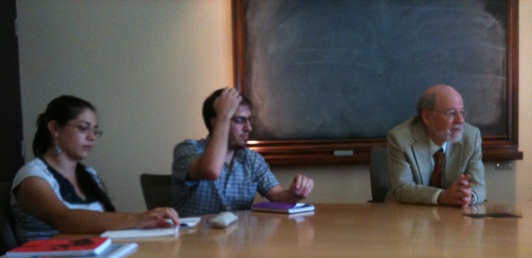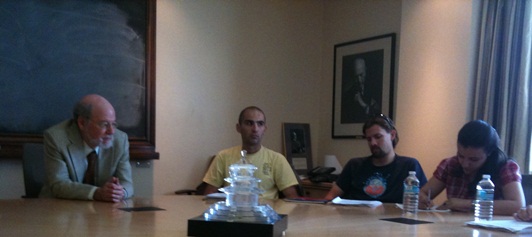Neurodegenerative Disorders and Brain Trauma
The 5th Canadian School of Neuroscience (May 23th to June 4th, 2011) on Neurodegenerative Disorders and Brain Trauma took place in Montreal and Quebec City. This North American/Canadian School of Neuroscience supports the idea that developed countries should become the base for international neuroscience education. A unique feature of the School is its close link to the annual meeting of the Canadian Association Neuroscience, a meeting that brings together over 1000 researchers mostly from across Canada and the United States.
Support
The School is grateful for support from the International Brain Research Organization, Canadian Association of Neuroscience, André Délarme Fondation, Brain@McGill, Montreal Neurological Institute, University of Toronto Neuroscience Program, AstraZeneca Montreal R&D.

Final social at the Coopers - Faculty & Students
The Students
The School’s organizing committee, in consultation with members of the IBRO Regional Committees for Africa (ARC) and Latin America (LARC) selected 12 students from over 125 applicants. The selection committees gave priority to candidates: a) who had previously attended an IBRO school and were already identified as promising and independent scientists; b) who demonstrated an interest in research on neurodegenerative disorders and brain trauma. The students included graduate students, postdoctoral trainees and junior staff and originated from Cameroons, Morocco, Nigeria, South Africa, Argentina, Cuba, Costa Rica, and Mexico. (Two students had difficulties obtaining the appropriate visas in time for the School and were unable to attend.)
All ten students were outstanding; their hard work during the long 10-12 hour days and their active participation made the entire educational program an extremely pleasurable and rewarding experience. Moreover, it was gratifying to read their positive evaluations.
The School
This year’s School consisted of three components. The first component took place in Montreal a week before the Canadian Neuroscience meeting, the second was the 3-day annual meeting, and the third component took place at Laval University, following the meeting. This arrangement allowed the School to integrate the Canadian meeting more fully into the school’s activities.
In Montreal, students attended interactive sessions on a wide range of topics related to the School’s theme, as well as on topics addressed by the main symposia and keynote addresses at the Canadian meeting. The core faculty included:
Dr. Philip Barker who discussed cellular mechanisms that regulate life and death decisions in the normal and damaged nervous system;
Professor Linda Cooper who explored different strategies and techniques to help scientists communicate most effectively;
Dr. Edward Fon who discussed molecular and cellular mechanisms of degeneration of dopamine neurons in Parkinson’s Disease;
Dr. Alyson Fournier who discussed molecular and cellular biology of neurite outgrowth and growth cone guidance, as well as current research on Multiple Sclerosis;
Dr. Julio Martinez-Trujillo who talked about his research on how the brain transforms visual signals into coordinated motor behavior and how this process is influenced by attention;
Dr. Anne McKinney who discussed mechanisms involved in development and maintenance of excitatory synapses in the hippocampus;
Drs. Donald van Meyel and Michel Cayouette who discussed molecular and organizational principles that underlie the assembly of functional neural circuits during development, and in particular, neural stem cells;
Dr. Adriana Di Polo who focused on molecular mechanisms underlying neuronal survival and axon regeneration in the injured visual system, as well as on the development of novel therapies for blindness;
Dr. David Ragsdale who discussed cellular mechanisms related to epilepsy and current electrophysiological techniques to investigate the biophysical properties of ion channels.
In addition to these interactive sessions, the students had demonstrations on electrophysiological techniques, live imaging of neurons using confocal and multiphoton microscopy, and electrophysiological recording from the visual areas in the cortex of primates, and they visited AstraZenenca Research facilities.
The Faculty did an excellent job of making their sessions engaging, tailoring their presentations to meet the students’ needs. The School had no “didactic” lectures per se and we believe that this contributed greatly to the students’ learning experience. The evening sessions was devoted to presentations and discussion of the students’ current research.


Prof Horvitz and students
In addition, while in Montreal, the students attended a special lecture by Dr. Robert Horvitz, Nobel Prize, 2002, who also generously met with the students and discussed a wide range of topics about careers in science.
After a week in Montreal, the School traveled to Quebec City for the 5th annual meeting of the Canadian Association of Neuroscience. Among their activities at this three-day meeting, the students attended the main meeting symposia on Neural Stem Cells and Development, Systems/Cognitive Neuroscience, and Microcircuits. They also attended Action to keynote addresses by Dr. F. Gage - Neural Plasticity and Neuronal Diversity, Dr. W. Newsome - Linking Reward: A Dynamic Systems Approach to Prefrontal Cortex Activity, and Dr. B. Sakmann - Digital Neuroanatomy – 3D Reconstruction of Anatomically Realistic Neuronal Networks.
Following their keynote addresses, both Drs. Gage and Sakmann met with the students, giving them a unique opportunity to discuss further aspects of Dr. Gage’s and Dr. Sakmann’s research in an informal setting. As well, they received valuable advice on how to make good career choices.
In addition, each student had a poster presentation at the meeting, allowing them to interact with other neuroscientists and to receive helpful feedback on their research.
After the meeting, the students had a 2-day session at Laval University where they discussed topics, at a more advanced level, related to the School’s themes.
The Laval University core faculty included:
Dr. Francesca Cicchetti who discussed the role of inflammation in Parkinson's and Huntington's diseases;
Dr. Nicolas Dupré who talked about hereditary ataxias: from the clinic to the laboratory;
Dr. Sébastien Hébert who focused on microRNAs in neurodegenerative diseases;
Dr. Jean-Pierre Julien who discussed new insights into ALS pathogenesis;
Dr. Jasna Kriz who talked about inflammation and plasticity after cerebral ischemia;
Dr. Steve Lacroix who focused on the role of the immune response in tissue damage and repair in the injured nervous system;
Dr. Benoit Lapointe who discussed the leukocyte recruitment into the central nervous system;
Dr. Emmanuel Planel who highlighted current research in Alzheimer's disease neuropathology;
Dr. Serge Rivest who discussed how innate immunity and bone marrow stem cells participate in rescuing brain diseases;
Dr. Cyril Schneider who talked about recent advance in neurostimulation to promote cerebral plasticity in patients with brain injured;
Dr. Luc Vallières who discussed the complicated picture of autoimmunity in multiple sclerosis.
Finally, we thank Dr. J. Makkerh, the School’s administrative coordinator, for helping to make this School so successful.
Guy Drolet and Ellis Cooper
School Coordinators |









